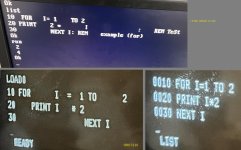voidstar78
Veteran Member
As an excuse to fire up the old systems, and celebrate BASIC now being over 50 years old - I ran the "Ahl Benchmark" on a few hardware systems that I have.

 voidstar.blog
voidstar.blog

Exploring Project Ahl in 2024 — voidstar
Some time ago, I came across an old Computer World article from 1980 that was comparing “$15,000 computers” (high end equipment at the time). That discussion is here. And the point of those articles was showing how some of the then-new-to-the-world microcomputers were seemingly catching up with...
 voidstar.blog
voidstar.blog
Code:
SYSTEM ACCURACY RANDOM-NESS TIME(S) YEAR CPU
IBM 5100 (1975) 0.000001566000 782.326940000000 184.3 1975 PALM
IBM 5110 (1978) 0.000000000346 954.589800000000 40.4 1978 PALM
IBM 5150 (4.77MHz) 0.01159668000 9.317505000000 23.9 1983 8088
NEC PC-8001 (1979) 0.03387450000 1.763920000000 90.7 1979 8088
NEC PC-8001 mk II (1983) 0.03387450000 1.763920000000 88.14 1983 8088
Sharp PC-5000 (1983) 0.00585937500 7.188416000000 29.7 1983 8088
Commodore PET (4032) 0.00104141235 7.323270560000 120.12 1980 6502
Commodore 64 (1MHz) 0.00104141235 1.155792950000 122.4 1982 6502
Apple IIe (1986 Platinum) 0.00104141235 0.821743011000 113.7 1986 6502
Tandy Color Computer 3 (6309) 0.00039628486 5.856625800000 142.5 1986 6309
Tandy Model 102 (1986) 0.00000020580 12.494425927600 295.8 1986 80C85
Commander X16 (8MHz 65C02) 0.00056564807 1.267472270000 7.8 2024 65C02
ACCURACY: 0 is perfect, lower is better. Each run is same accuracy.
RANDOM-NESS: 0 is perfect, lower is better. 1-30 is good, larger is poorer but not bad.
TIME: Elapsed time to run the benchmark in seconds.
YEAR: Initial year the given system was released.
voidstar - May 2024 - REV #1

